Cave Automatic Virtual Environment

The English term Cave Automatic Virtual Environment (abbreviated: CAVE ; literally translated: Cave with an automated, virtual environment ) describes a space for the projection of a three-dimensional illusionary world of virtual reality . From the 1990s onwards, the system was used primarily in research and industry, for example in car design. In contrast to head-mounted displays , a CAVE offers several users the opportunity to experience a virtual world at the same time.
Details
The NCSA defines CAVE as " an immersive virtual reality facility designed for the exploration of and interaction with spatially engaging environments ". A CAVE can be realized in different ways. One possibility is a cube with up to six projection surfaces, so under certain circumstances a glass floor is irradiated with projectors from below, and a wall may have to be moved to enter the room. In addition to projections, CAVES can also be implemented using 3D-capable LED walls or LC displays.
The name CAVE deliberately recalls the allegory of the cave in Plato's Republic , which deals with the relationship between perception and knowledge as well as reality and illusion .
The prototype of a device for real-time visualization of art and science for several people in one room was developed by the art professor Daniel Sandin and the computer scientists Tom DeFanti and Carolina Cruz-Neira at the University of Illinois at Chicago and presented at the SIGGRAPH in 1992 .
A comparable VR system is ImmersaDesk . A related technique is immersion .
application areas
A CAVE can be used for different areas:
- In the field of CAD , CAVE systems are increasingly being used, which are intended to convey to the developers the later appearance of devices or buildings in a three-dimensional panorama system.
- Construction / Telepresence: Engineers can work on virtual constructions over large distances with CAVE technology.
- Simulation: In the training and education sector, systems are used in which the trainees can move around in a CAVE and even interact with computer-controlled figures, e.g. B. Flight simulators .
- Medical research: Scientists use CAVEs for a variety of medical projects, for example to visualize the heart, enzymes or for DNA research.
- Entertainment: The immersion in video games is enhanced. Functional ports already exist for the 3D games Doom , Quake II and Quake III Arena .
- Use in the field of psychology and psychotherapy (e.g. virtual spaces in the form of immersive art using the example of AlphaSphere ).
Alternatives
Another possibility to immerse the user in an artificial world is to display it on a head-mounted display .
literature
- Tom Sperlich: News in the data cave . In: Die Zeit No. 47, November 15, 1996, 78.
swell
- ↑ Communications of the ACM, vol 35, no 6, pp. 65-72 [Cruz-Neira, C., Sandin, D., DeFanti, T., Kenyon, R., Hart, J.]
- ↑ Thomas Slunecko, A. Univ. Professor at the Faculty of Psychology at the University of Vienna Immersive art as a therapeutic option Effect study on an art object, the so-called AlphaLiege by the Viennese artist sha. ( Page no longer available , search in web archives ) Info: The link was automatically marked as defective. Please check the link according to the instructions and then remove this notice.
Web links
- Dave's CAVE pages (English)
